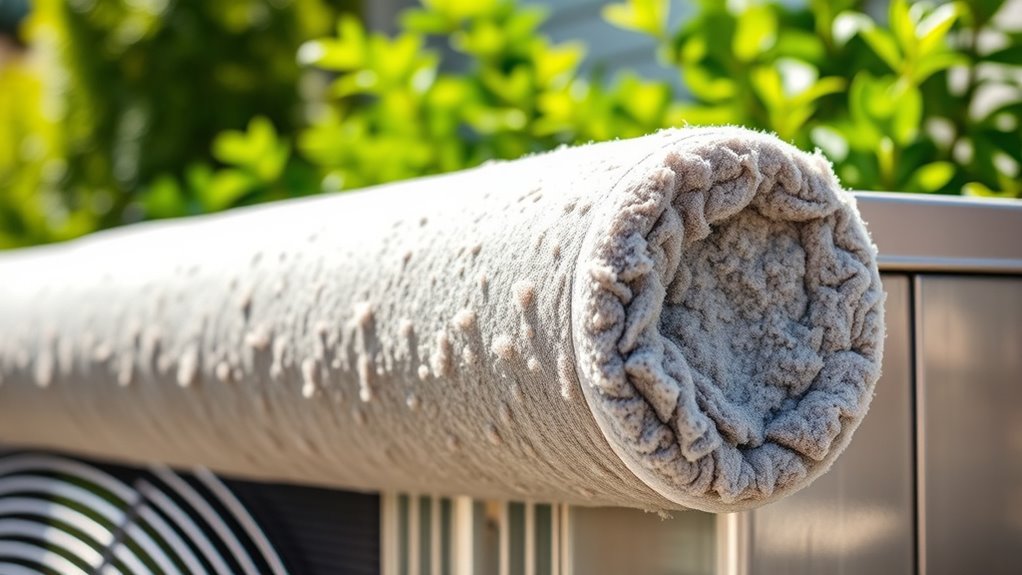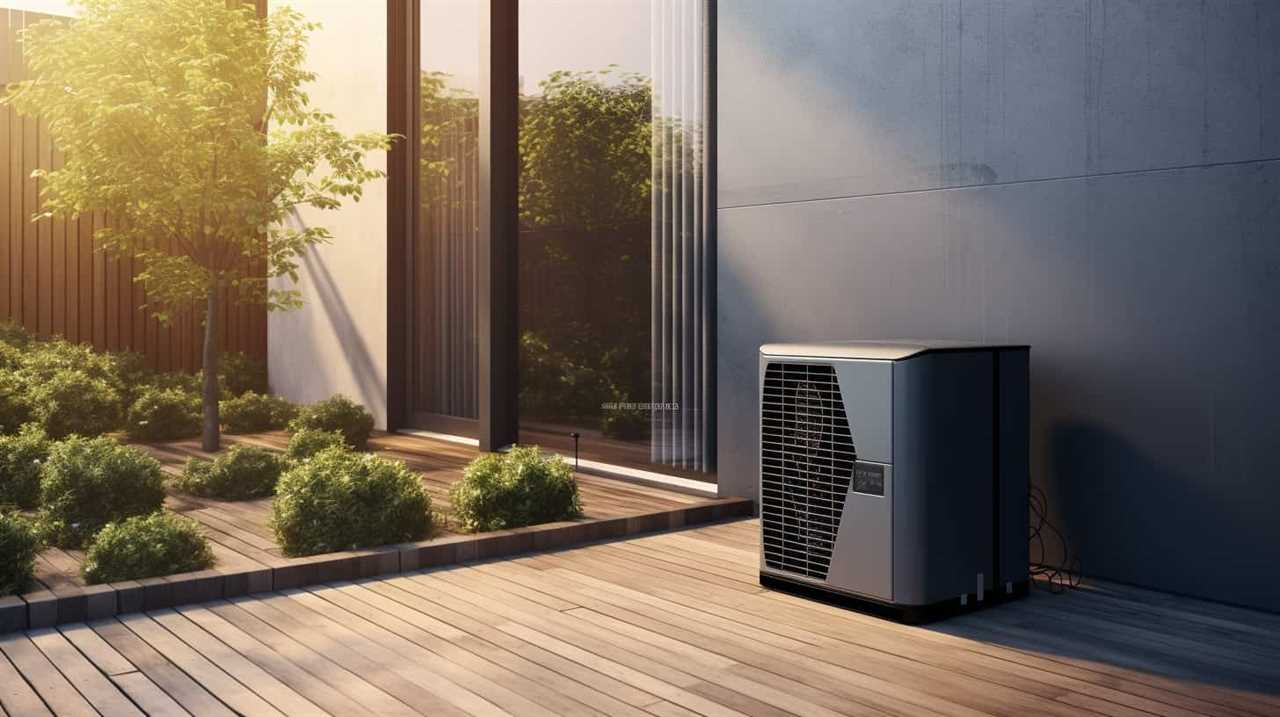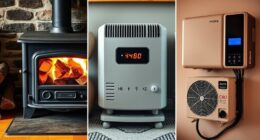Proper insulation plays a key role in maximizing your heat pump’s efficiency. It reduces unwanted heat transfer, helping maintain stable indoor temperatures and lowering energy bills. By insulating key areas like attics, walls, and floors, you prevent heat loss in winter and heat gain in summer. Sealing gaps and choosing the right materials further boost performance. Want to discover how to optimize your home for better energy savings? Keep exploring for more tips.
Key Takeaways
- Insulation reduces unwanted heat transfer, maintaining stable indoor temperatures and supporting heat pump efficiency.
- Proper insulation minimizes heat loss in winter and heat gain in summer, easing the heat pump’s workload.
- Higher R-values in insulation improve thermal resistance, enhancing the heat pump’s ability to operate efficiently.
- Sealing gaps and thermal bridging with insulation prevents air leaks, improving overall thermal performance.
- Moisture-resistant insulation maintains integrity and thermal performance in humid environments, supporting consistent heat pump operation.
How Insulation Enhances Heat Pump Efficiency
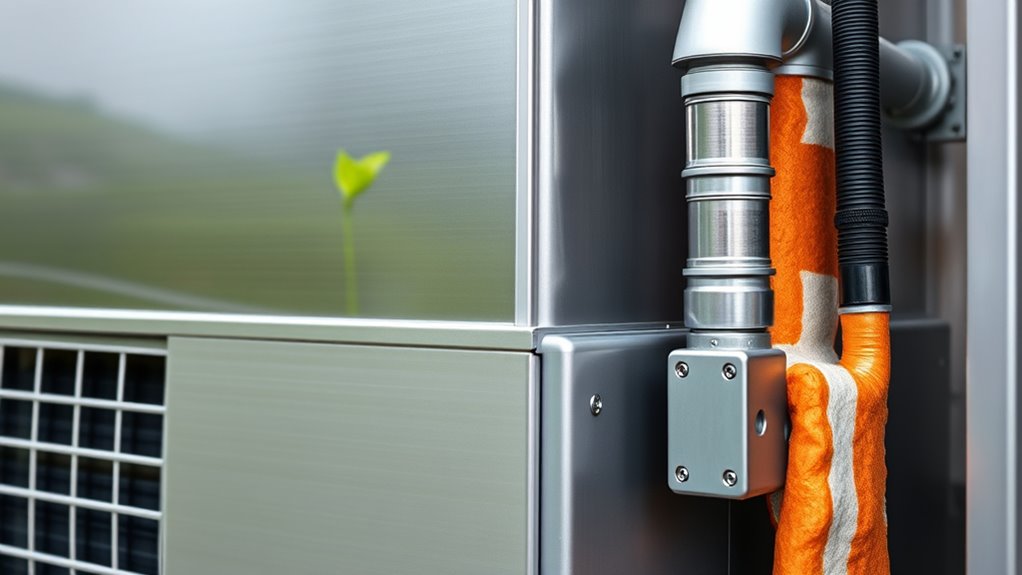
Proper insulation plays a crucial role in boosting your heat pump’s efficiency. It reduces unwanted heat transfer, helping your system maintain a stable indoor temperature and improving thermal performance. Well-insulated homes experience less heat loss in winter and heat gain in summer, easing the workload on your heat pump. This means fewer cycles, lower energy consumption, and significant energy savings. Additionally, insulation minimizes system strain caused by temperature fluctuations, extending the lifespan of your equipment. Studies show that proper insulation can improve heat pump efficiency by up to 30%, which translates into reduced utility bills. By preventing excessive heat transfer, insulation ensures your heat pump operates smoothly and effectively, providing consistent comfort while maximizing energy savings. Incorporating AI data analysis can further optimize insulation strategies for enhanced system performance, and implementing insulation upgrades is often a cost-effective way to improve overall home energy efficiency. Moreover, understanding the thermal properties of insulation materials can help in selecting the most effective options for your specific climate and building type. Properly installed insulation also reduces energy waste, contributing to a more sustainable and environmentally friendly home.
The Relationship Between Thermal Performance and Energy Use

When your home is well-insulated, it can better maintain a steady indoor temperature, which directly impacts your heat pump‘s energy use. Improved thermal performance reduces heat transfer, decreasing heat loss in winter and heat gain in summer. This leads to a more comfortable living environment and lower utility bills. To visualize this: 1. Fewer drafts and cold spots keep your indoor temperature stable. 2. Enhanced thermal resistance prevents unwanted heat transfer. 3. Less frequent cycling of your heat pump conserves energy and extends its lifespan. Additionally, proper insulation minimizes thermal bridging, further improving efficiency and reducing energy costs.
Key Areas to Insulate for Optimal Heat Pump Operation
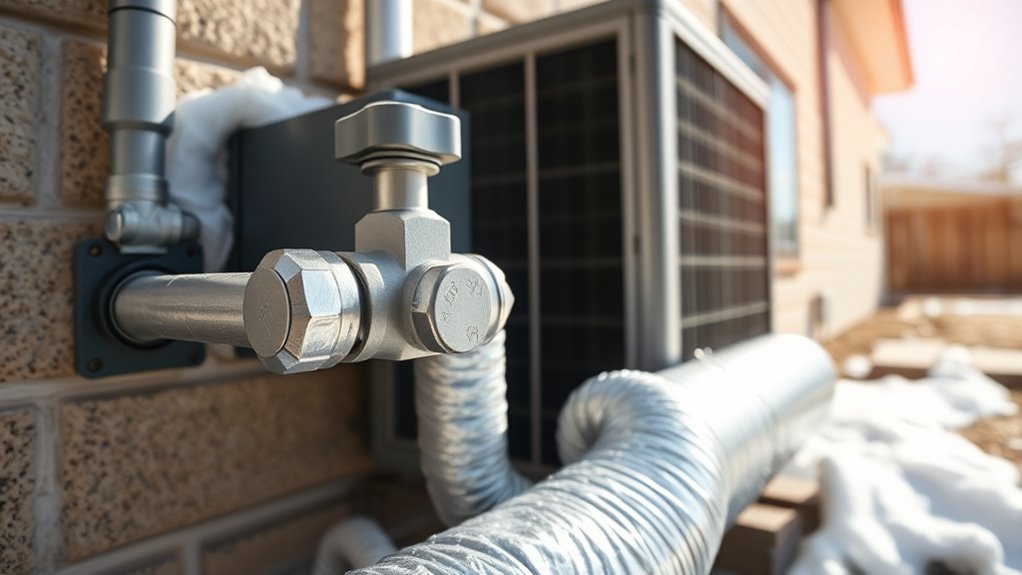
To maximize your heat pump’s efficiency, focus on insulating the key areas of your home where heat loss is most significant. Proper insulation reduces heat transfer and maintains thermal performance. Start with attic insulation, which can improve heat retention by up to 50%, easing your heat pump’s workload in winter. Ensure exterior walls have an R-value of at least 13-21 to minimize heat transfer. Seal and insulate rim joists to prevent up to 30% of air leaks, keeping indoor temperatures stable. Insulate floors over unheated spaces to cut heat loss by 20-30%. Addressing air leaks through proper sealing can further enhance insulation effectiveness. Incorporating effective insulation techniques can make a significant difference in overall energy savings. Additionally, upgrading insulation materials can further improve thermal retention. For optimal results, consider evaluating your home’s energy efficiency and implementing comprehensive insulation strategies. Finally, target windows and doors with insulation to reduce drafts. These measures help your heat pump operate more efficiently, saving energy and enhancing overall energy efficiency in your home. Incorporating natural techniques for energy conservation can further optimize your home’s thermal performance.
Benefits of a Well-Sealed Home Envelope

A well-sealed home envelope directly boosts your heat pump’s efficiency by minimizing unwanted air exchange. When you seal gaps around windows, doors, and ductwork, you prevent air leaks that cause unwanted heat transfer. Imagine:
- An airtight home that keeps warm air in during winter and cool air in during summer.
- Reduced heat loss and gain, helping your system operate more effectively.
- Less drafts and cold spots, leading to a more stable indoor climate.
Sealing gaps around outlets and vents prevents conditioned air from escaping, saving energy and lowering bills. Combining sealing with insulation improves thermal performance and can increase overall energy savings by up to 20%. A tightly sealed home envelope minimizes heat transfer, ensuring your heat pump works smarter, not harder. Proper sealing techniques are especially important when considering the horsepower of electric dirt bikes, which mirrors the importance of sufficient power in energy systems to achieve optimal performance.
Additionally, implementing air sealing techniques is a key component of a home energy efficiency strategy and a comprehensive approach to enhancing home energy efficiency and thermal comfort.
Furthermore, proper sealing can also help reduce air infiltration, which is crucial for maintaining consistent indoor temperatures and reducing strain on your heating and cooling systems.
Impact of Insulation on Indoor Temperature Stability
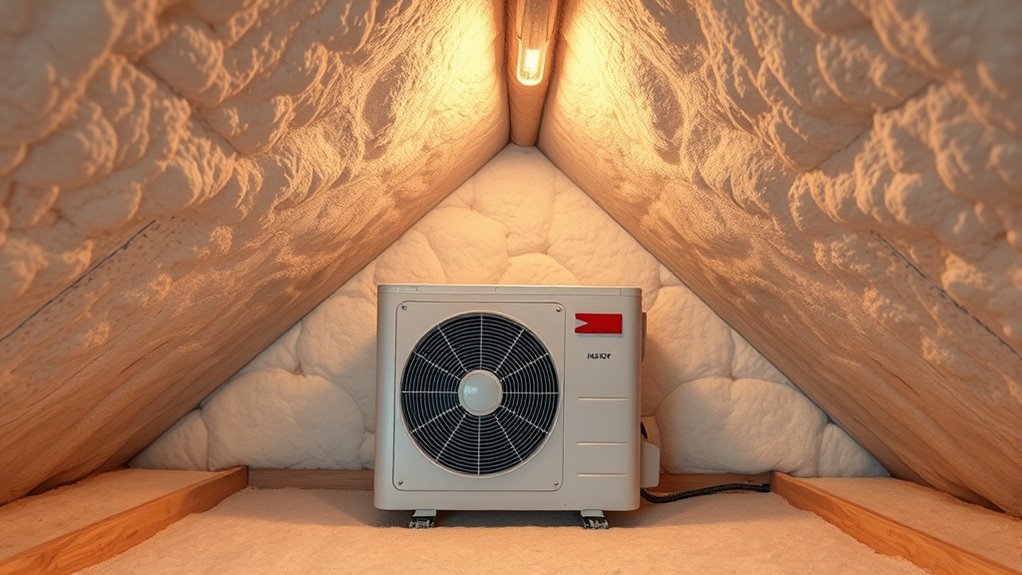
Proper insulation helps keep your indoor temperatures steady by reducing heat transfer through walls, ceilings, and floors. With better insulation, your heat pump runs more consistently, minimizing temperature swings. This thermal buffer not only enhances comfort but also makes your system more efficient and less prone to strain.
Consistent Indoor Comfort
When your home is well-insulated, you experience fewer temperature fluctuations because insulation acts as a thermal barrier that minimizes heat transfer through walls, ceilings, and floors. This ensures your indoor temperatures stay steady, reducing the need for constant adjustments. Imagine:
- A cozy living room, where heat stays in during winter, keeping you warm without overworking your heat pump.
- A cool bedroom in summer, with insulation preventing hot air from seeping in.
- Proper insulation techniques further optimize heat retention, supporting stable indoor climates and reducing heat loss. It helps your heat pump operate more efficiently, providing reliable indoor comfort while minimizing temperature swings caused by heat transfer. Additionally, thermal performance can be significantly improved by addressing gaps and weak points in your insulation, further enhancing energy efficiency.
Temperature Fluctuation Reduction
Insulation plays a crucial role in reducing indoor temperature fluctuations by limiting heat transfer through walls, ceilings, and floors. When properly installed, insulation helps maintain temperature stability, preventing cold spots in winter and hot spots in summer. This consistent environment enhances comfort and reduces energy costs. Sealing gaps and cracks further reduces air leaks, boosting thermal efficiency and decreasing drafts that cause temperature swings. As a result, your home stays comfortable longer, and the heat pump works more efficiently. Improved insulation minimizes the demand for heating and cooling, supporting energy conservation. Additionally, thermal performance is optimized when insulation is combined with proper ventilation and sealing techniques. Proper insulation also reduces the workload on heating and cooling systems, leading to longer equipment lifespan and lower maintenance costs. By reducing temperature fluctuations, insulation guarantees a stable indoor environment, making your home more comfortable and less energy-intensive year-round.
Insulation’s Thermal Buffer
Have you ever wondered how some homes stay comfortable despite outside temperature swings? That’s the power of insulation’s thermal buffer. It minimizes heat transfer through walls, ceilings, and floors, helping maintain indoor temperature stability. Imagine:
- A wall acting like a thermal barrier, resisting heat infiltration during summer and heat loss in winter.
- Your home’s interior remaining within a narrow temperature range, even as outside conditions change.
- The insulation’s R-value working behind the scenes, boosting thermal resistance and heat retention. Additionally, insulation materials play a crucial role in enhancing this thermal buffer by affecting the overall insulation quality and performance. Using appropriate insulation techniques can further optimize thermal performance and energy efficiency. Incorporating proper installation methods ensures that the insulation functions as intended, preventing gaps and thermal bridging that can undermine its effectiveness.
This thermal insulation reduces temperature fluctuations, ensuring consistent comfort. With higher R-values, your insulation provides a stronger thermal buffer, preventing heat infiltration and loss. As a result, your heat pump operates more efficiently, prolonging system life and enhancing temperature stability. Additionally, the choice of insulation material can significantly impact the overall thermal performance of your home.
Insulation Materials and Their Effectiveness
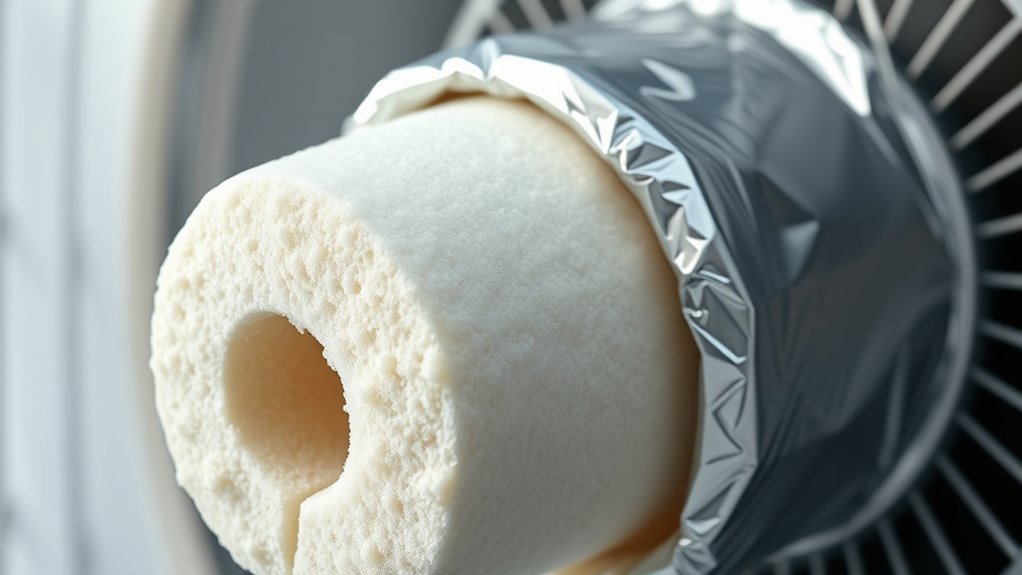
Choosing the right insulation materials directly affects your heat pump’s efficiency and your home’s energy use. Materials like spray foam, fiberglass, and rigid foam each offer different R-values and performance benefits, including moisture resistance. Understanding these options helps you select the best insulation for ideal thermal performance. Proper insulation can also help reduce heat loss by minimizing gaps and cracks, further enhancing your heating system’s thermal efficiency. Additionally, high-quality insulation can support the overall effectiveness of a keto diet, by maintaining consistent temperatures and reducing energy consumption.
R-Value Significance
Ever wonder why some heat pumps run more efficiently than others? It all comes down to R-value. This measure indicates how well insulation resists heat transfer. Higher R-values mean better thermal performance and less heat loss or heat gain. For example:
- R-30 to R-60 insulation in attics minimizes heat transfer, keeping indoor temps steady.
- Better insulation materials, like spray foam or rigid foam, achieve higher R-values per inch.
- Proper R-value selection reduces the workload on your heat pump, boosting energy efficiency.
When your insulation has a high R-value, it prevents unwanted heat flow, ensuring your system doesn’t work harder than necessary. This results in improved thermal performance and lower energy costs, making your heat pump more effective year-round.
Material Types & Performance
Selecting the right insulation material directly impacts your system’s thermal performance and energy efficiency. Different insulation materials offer varying R-values and thermal resistance, influencing how well they resist heat transfer. Fiberglass insulation, with an R-value of about 2.2 to 4.3 per inch, is cost-effective but less air-tight than spray foam. Spray foam insulation provides higher R-values—up to 6.5 per inch—and creates an air-tight seal that enhances thermal performance. Rigid foam offers R-values from 4 to 8 per inch, making it suitable for exterior walls and foundations. Radiant barrier insulation, made of reflective foil, minimizes heat transfer by reflecting radiant heat, especially in hot climates. Proper installation and appropriate thickness are essential for maximizing insulation materials’ effectiveness.
Moisture Resistance Benefits
Moisture-resistant insulation materials, such as closed-cell spray foam and rigid foam boards, actively prevent mold growth by limiting moisture infiltration within walls and attics. These materials enhance thermal performance and help maintain heat pump efficiency by reducing humidity-related issues. Imagine:
- Barrier to water absorption, keeping insulation intact and preventing structural damage.
- Consistent thermal retention even in high-humidity environments, ensuring reliable heat flow.
- Improved durability that withstands moisture exposure, extending insulation lifespan.
Timing Insulation Upgrades for Maximum Savings
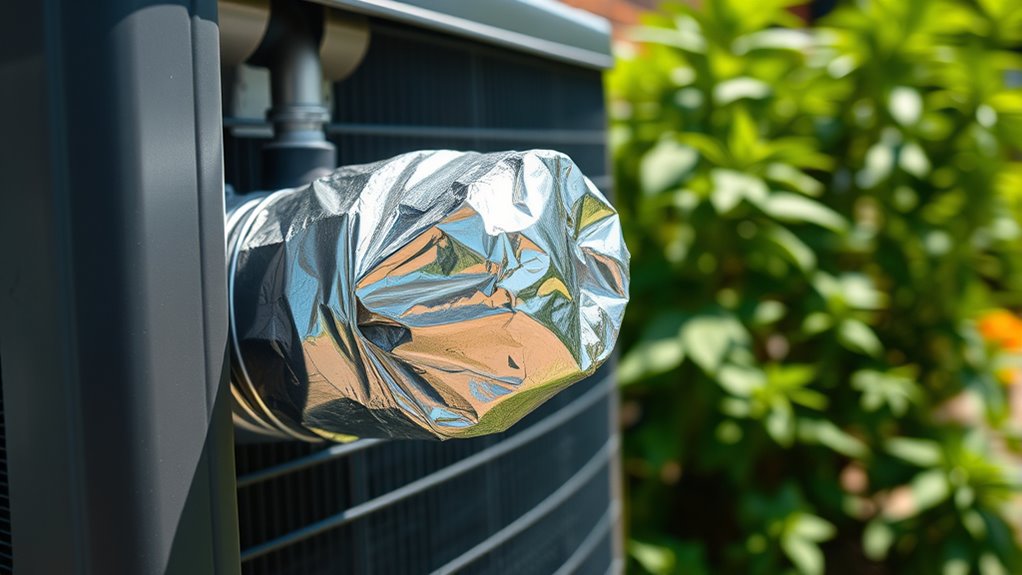
Timing your insulation upgrades before installing a heat pump is a smart move to maximize energy savings. Doing so improves thermal performance and reduces heat transfer, allowing your HVAC system to run more efficiently. An energy audit helps identify key areas like attics, walls, and basement rim joists that need insulation improvements. When you bundle insulation upgrades with your heat pump installation, you often qualify for rebates from programs like NYSERDA and the Inflation Reduction Act, boosting your savings. Proper timing guarantees your heat pump operates at peak performance, lowering utility bills and achieving faster energy savings. Here’s a quick overview of essential areas to upgrade:
| Area | Benefit of Insulation Upgrade |
|---|---|
| Attic | Reduces heat loss |
| Walls | Improves thermal performance |
| Basement | Minimizes heat transfer |
| Rim Joists | Enhances overall efficiency |
| Floors | Maintains consistent comfort |
How to Assess Your Home’s Insulation Needs

To accurately assess your home’s insulation needs, start with a thorough energy audit. This will help you identify areas with significant heat loss, such as attics, walls, and basement rim joists. Use thermal imaging or infrared cameras to spot insulation gaps, cold spots, and air leaks that cause uneven indoor temperatures. Check the current R-value of your existing insulation to see if it meets recommended levels—typically R-49 or higher for attics in your climate zone. Also, evaluate the age and type of insulation, since older materials like fiberglass batts may have degraded. Focus on insulating high-heat-loss areas first—like exterior walls and attics—to improve heat transfer, boost heat pump efficiency, and reduce overall insulation needs.
Combining Insulation With HVAC Strategies for Best Results
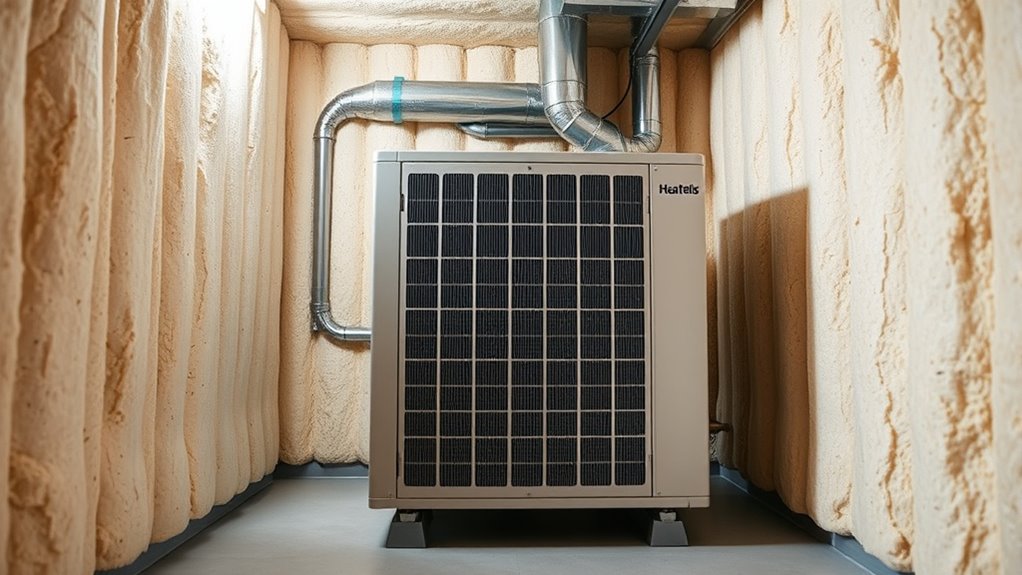
Pairing your home’s insulation upgrades with strategic HVAC strategies can substantially boost your heat pump’s performance. Proper insulation minimizes heat transfer, helping the heat pump operate efficiently and maintain consistent indoor temperatures. Upgrading insulation before installation reduces the system’s workload, extending its lifespan. Sealing air leaks alongside insulation enhances the thermal envelope, preventing unwanted heat loss and improving energy efficiency. Combining insulation with HVAC strategies like sealing gaps and optimizing airflow can improve thermal performance by up to 50%, cutting your energy use. Additionally, an extensive approach can lead to energy savings of 20-30% annually. By integrating insulation with HVAC practices, you ensure your heat pump works smarter, lasts longer, and keeps your home comfortable while reducing utility bills.
Frequently Asked Questions
Why Do Heat Pumps Need Better Insulation?
You need better insulation because it helps your heat pump work more efficiently. When your home is well-insulated, it keeps the desired temperature steady, reducing heat loss in winter and heat gain in summer. This means your heat pump doesn’t have to run as often or work as hard, saving you energy and lowering your bills. Good insulation also protects your system’s lifespan and keeps your home more comfortable year-round.
What Is the Main Purpose of Thermal Insulation?
The main purpose of thermal insulation is to keep your indoor environment comfortable by reducing heat transfer between inside and outside. It acts as a barrier, preventing heat from escaping in winter and entering in summer, which helps maintain a steady temperature. This reduces the workload on your heat pump, lowers energy bills, and enhances overall comfort by stabilizing indoor conditions regardless of the weather outside.
How Does Thermal Insulation Increase Efficiency?
Think of thermal insulation as your home’s warm blanket. It keeps heat in during winter and out during summer, reducing the workload on your heat pump. By minimizing heat transfer, insulation helps your system work less and more efficiently. You save energy, lower bills, and extend the lifespan of your heat pump. fundamentally, insulation shields your comfort, making your system perform at its best with less effort.
How Much Insulation Do You Need for a Heat Pump?
You should aim for attic insulation with an R-value of 13 to 15 and wall insulation between R-13 and R-21, depending on your climate. Colder areas need higher R-values to prevent heat loss. Conduct an energy audit to identify specific needs. Proper insulation not only boosts your heat pump’s efficiency but also cuts energy costs by up to 30%, making your home more comfortable and saving money.
Conclusion
By upgrading your insulation, you can boost your heat pump’s efficiency by up to 20%. A well-insulated home reduces energy consumption and keeps your indoor temperatures stable year-round. Don’t overlook key areas like attic and basement insulation, which can make a big difference. When you combine proper insulation with smart HVAC strategies, you’ll enjoy lower bills and more comfort. Investing in insulation now is a smart move for long-term savings and sustainability.
